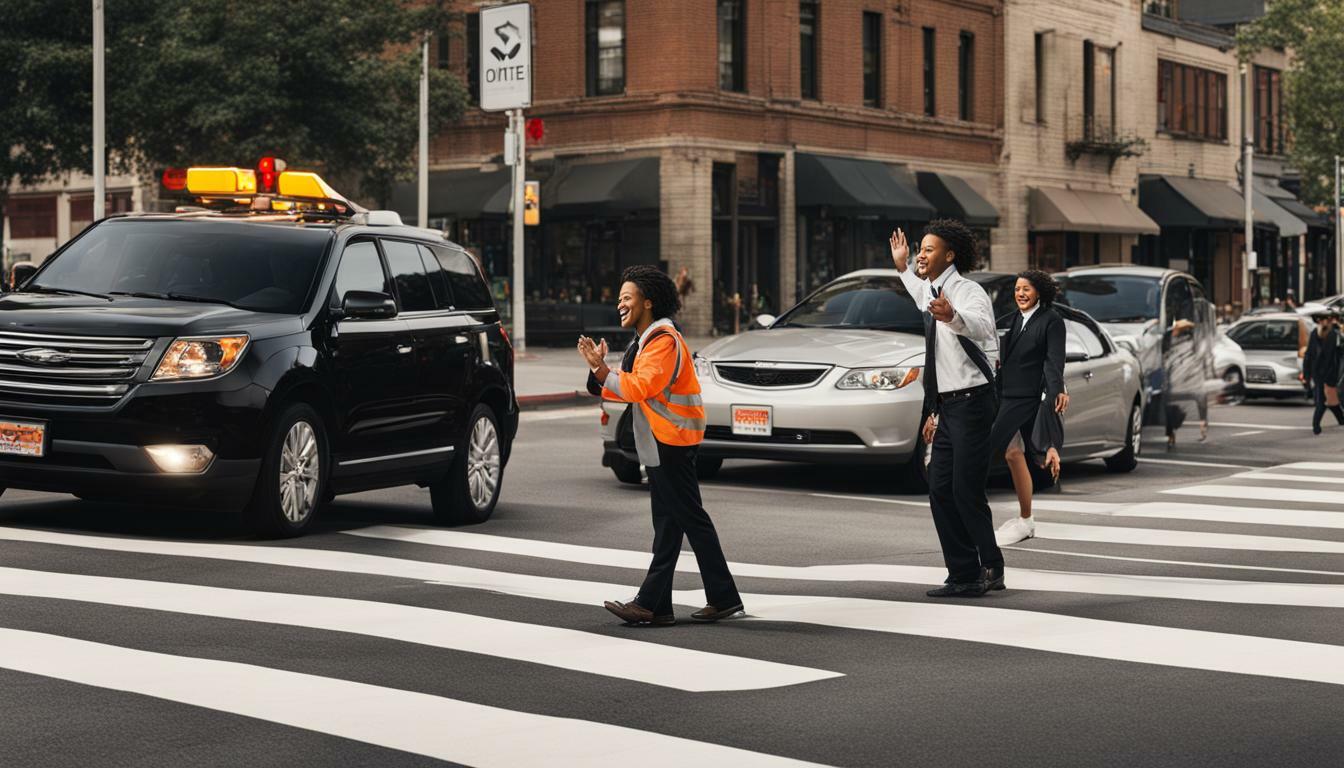Safe and courteous driving is crucial for being a responsible driver and ensuring traffic safety. It means following traffic rules, being aware of your surroundings, and showing respect to other motorists and pedestrians.
Tips for being a thoughtful and courteous driver include maintaining a safe distance, driving at a safe speed, signaling before turning or changing lanes, obeying stop signs and red lights, giving the right of way to pedestrians, not blocking intersections, avoiding tailgating or reckless driving, and not succumbing to road rage.
Being courteous on the road also involves being patient, respecting other drivers, avoiding aggressive behavior, reducing stress by planning routes ahead, and not letting distractions or bad manners lead to accidents. Overall, safe and courteous driving is a sign of professionalism and can contribute to a safer road environment.
Key Takeaways:
- Safe and courteous driving is essential for responsible drivers and traffic safety.
- Follow traffic rules and show respect to other motorists and pedestrians.
- Maintain a safe distance, obey speed limits, and use turn signals appropriately.
- Be patient, avoid aggressive behavior, and reduce stress while driving.
- Practice good manners and focus on creating a safer road environment.
The Basics of Safe and Courteous Driving
Responsible driving involves obeying traffic rules and implementing safe driving practices. It is crucial to prioritize the safety of oneself and others on the road. Being a thoughtful and courteous driver not only reduces the risk of accidents but also contributes to a positive and harmonious driving environment.
Here are some key tips to help you become a safe and courteous driver:
- Maintain a safe distance: Keep a safe distance from the vehicle in front of you to allow for ample reaction time in case of sudden stops or emergencies.
- Drive at a safe speed: Adhere to speed limits and adjust your speed according to the road and weather conditions.
- Signal before turning or changing lanes: Use your indicators to communicate your intentions to other drivers, ensuring a smooth and predictable flow of traffic.
- Obey stop signs and red lights: Come to a complete stop at stop signs and red lights, allowing other vehicles and pedestrians to proceed safely.
- Give the right of way to pedestrians: Always yield to pedestrians at crosswalks and intersections to prioritize their safety.
Remember, being a courteous driver means showing respect to others on the road. It entails avoiding tailgating, reckless driving, blocking intersections, and succumbing to road rage. Patience and understanding go a long way in creating a safer and more pleasant driving experience for everyone.
Reducing stress and distractions is also important for safe and courteous driving. Plan your routes ahead to minimize the chances of getting lost or making sudden maneuvers. Avoid aggressive behavior and maintain a calm mindset, even in challenging situations. By staying focused on the road and avoiding distractions such as mobile phones or excessive conversation, you can ensure that your attention remains where it should be – on driving safely.
| Safe and Courteous Driving | Defensive Driving Techniques |
|---|---|
| Obey traffic rules | Anticipate potential hazards |
| Maintain a safe distance | Stay alert and focused |
| Signal before turning | Practice proactive driving |
| Give right of way to pedestrians | React calmly to unexpected situations |
Above all, safe and courteous driving is a sign of professionalism. By adopting responsible driving habits and being considerate towards others, we can create a safer road environment for everyone. So let's make a commitment to drive safely, follow traffic rules, and treat fellow road users with respect. Together, we can make a positive impact on our roads and ensure a smooth and enjoyable journey for all.
Defensive Driving Techniques for a Safer Road
By adopting defensive driving techniques, you can minimize risks and create a safer road environment for everyone. Defensive driving is all about being proactive and anticipating potential hazards. Here are some essential defensive driving tips to keep in mind:
- Stay focused and avoid distractions: Keep your attention on the road at all times. Avoid using your phone, eating, or engaging in any other activities that may take your focus away from driving.
- Maintain a safe distance: Leave enough space between your vehicle and the one ahead of you. This will give you enough time to react and prevent rear-end collisions.
- Observe and anticipate: Continuously scan the road ahead and be aware of your surroundings. Look for potential hazards such as pedestrians, cyclists, or other unpredictable drivers.
- Use your mirrors effectively: Regularly check your rearview and side mirrors to be aware of other vehicles around you. This will help you make informed decisions when changing lanes or merging with traffic.
Remember, defensive driving is not just about your own actions, but also about being considerate of others on the road.
Here's a quote from John Doe, a certified defensive driving instructor: “Defensive driving is all about proactive thinking and taking necessary precautions to reduce the risk of accidents. It's about being a responsible driver and making the road safer for everyone.”
Applying defensive driving techniques can significantly reduce the chances of being involved in an accident. It also helps in minimizing the impact of unexpected situations, such as sudden braking or swerving by other drivers. By practicing defensive driving, we can create a culture of safety on the roads and protect ourselves and others from harm.
| Defensive Driving Tips | Benefits |
|---|---|
| Avoid tailgating or reckless driving | Reduces the risk of rear-end collisions |
| Obey traffic rules and signs | Promotes order and reduces confusion on the road |
| Show respect to other drivers | Fosters a cooperative and harmonious driving environment |
| Stay calm and avoid road rage | Reduces stress and decreases the likelihood of aggressive behavior |
Remember, safe and courteous driving is not just a responsibility, but also a reflection of your professionalism. So, let's all adopt defensive driving techniques and contribute to making our roads safer for everyone.
Practicing Courtesy Behind the Wheel
Practicing courtesy behind the wheel is essential for fostering a harmonious and respectful driving culture. As responsible drivers, it is our duty to create a safe and pleasant environment on the road for ourselves and others. By following courteous driving habits and adhering to proper driving etiquette, we can contribute to a positive driving experience and reduce the risk of accidents.
One of the key aspects of practicing courtesy on the road is maintaining a safe distance from the vehicle ahead. This not only allows for better reaction time in case of sudden stops or maneuvers but also helps to avoid unnecessary tailgating. Remember, a safe following distance is essential for the safety of everyone on the road.
In addition to maintaining a safe distance, signaling before turning or changing lanes is another crucial aspect of courteous driving. Signaling not only informs other road users of your intentions but also promotes predictability and communication, reducing the risk of collisions. It is a simple yet important gesture that shows respect for your fellow drivers.
Moreover, respecting the right of way for pedestrians and not blocking intersections are vital aspects of courteous driving. Giving pedestrians the priority they deserve demonstrates our commitment to their safety and promotes a culture of empathy on the road. By avoiding blocking intersections, we can help maintain a smooth flow of traffic and prevent frustrating situations for ourselves and others.
| Courteous Driving Habits | Driving Etiquette |
|---|---|
| Maintain a safe distance | Signal before turning or changing lanes |
| Respect the right of way for pedestrians | Avoid blocking intersections |
| Avoid tailgating or reckless driving | Be patient and respectful to other drivers |
By practicing these courteous driving habits and following proper driving etiquette, we not only enhance our own safety but also create a positive impact on the road. Safe and courteous driving is a sign of professionalism and contributes to a safer and more enjoyable driving experience for everyone.
Dealing with Road Rage and Distractions
Dealing with road rage and distractions is vital for maintaining focus and promoting safe driving. Avoiding aggressive behavior towards other drivers is crucial in preventing conflicts and potential accidents on the road. Being patient and respectful towards fellow motorists can create a more harmonious driving environment for everyone.
Reducing stress is another key aspect of safe and courteous driving. Planning your routes ahead of time can help minimize the chances of getting lost or feeling rushed while behind the wheel. By knowing your route and allowing for extra time, you can avoid the stress of being late and the temptation to speed or take unnecessary risks.
Distractions are a major hazard on the road, so it's important to minimize them as much as possible. Avoid using your cellphone while driving and refrain from activities that divert your attention, such as eating, grooming, or adjusting electronic devices. Remember, even a momentary lapse in concentration can have serious consequences.
Quotes
Safe driving is not just about following the rules; it's about being aware of your surroundings, adapting to changing conditions, and showing respect to others on the road. – Anonymous
By practicing safe and courteous driving habits, you can contribute to a safer road environment for everyone. Remember to stay calm, be considerate of others, and prioritize safety at all times. Together, we can make our roads a better place for everyone.
| Tips for Safe and Courteous Driving |
|---|
| Maintain a safe distance from the vehicle in front of you. |
| Obey traffic rules, including stop signs and red lights. |
| Signal before turning or changing lanes. |
| Give the right of way to pedestrians. |
| Do not block intersections. |
| Avoid tailgating or reckless driving. |
| Be patient and avoid aggressive behavior. |
| Plan your routes ahead to reduce stress. |
| Minimize distractions by focusing on the road. |
Conclusion
By prioritizing safe driving practices, taking defensive driving courses, and practicing driving etiquette, we can contribute to a safer and more enjoyable road experience for everyone.
Safe and courteous driving is crucial for being a responsible driver. It means following traffic rules, being aware of your surroundings, and showing respect to other motorists and pedestrians.
Tips for being a thoughtful and courteous driver include maintaining a safe distance, driving at a safe speed, signaling before turning or changing lanes, obeying stop signs and red lights, giving the right of way to pedestrians, not blocking intersections, avoiding tailgating or reckless driving, and not succumbing to road rage.
Being courteous on the road also involves being patient, respecting other drivers, avoiding aggressive behavior, reducing stress by planning routes ahead, and not letting distractions or bad manners lead to accidents. Overall, safe and courteous driving is a sign of professionalism and can contribute to a safer road environment.
FAQ
Why is safe and courteous driving important?
Safe and courteous driving is important to ensure the safety of everyone on the road. It helps prevent accidents and promotes a harmonious driving environment.
What are some basic safe driving practices?
Basic safe driving practices include following traffic rules, maintaining a safe distance, driving at a safe speed, and obeying stop signs and red lights.
What is defensive driving?
Defensive driving is a technique that involves being proactive and anticipating potential hazards on the road. It focuses on anticipating the actions of other drivers and taking necessary precautions to avoid accidents.
How can I practice courtesy behind the wheel?
You can practice courtesy by maintaining a safe distance, signaling before turning or changing lanes, giving the right of way to pedestrians, and not blocking intersections.
How can I avoid road rage and distractions while driving?
To avoid road rage and distractions, it is important to stay calm, plan routes ahead, and minimize distractions such as using electronic devices or engaging in aggressive behavior.
How can safe and courteous driving contribute to a safer road environment?
Safe and courteous driving creates a safer road environment by reducing the risk of accidents and promoting cooperation among drivers. It sets a positive example for others and helps maintain order on the roads.



